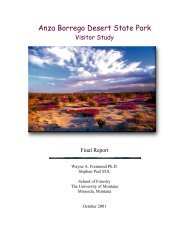Final Mitigated Negative Declaration and Response to Comments
Final Mitigated Negative Declaration and Response to Comments
Final Mitigated Negative Declaration and Response to Comments
Create successful ePaper yourself
Turn your PDF publications into a flip-book with our unique Google optimized e-Paper software.
Important Information About Your Species List<br />
How We Make Species Lists<br />
We s<strong>to</strong>re information about endangered <strong>and</strong> threatened species lists by U.S. Geological Survey 7½ minute<br />
quads. The United States is divided in<strong>to</strong> these quads, which are about the size of San Francisco.<br />
The animals on your species list are ones that occur within, or may be affected by projects within, the quads<br />
covered by the list.<br />
<br />
<br />
<br />
Fish <strong>and</strong> other aquatic species appear on your list if they are in the same watershed as your quad or<br />
if water use in your quad might affect them.<br />
Amphibians will be on the list for a quad or county if pesticides applied in that area may be carried<br />
<strong>to</strong> their habitat by air currents.<br />
Birds are shown regardless of whether they are resident or migra<strong>to</strong>ry. Relevant birds on the county<br />
list should be considered regardless of whether they appear on a quad list.<br />
Plants<br />
Any plants on your list are ones that have actually been observed in the area covered by the list. Plants may<br />
exist in an area without ever having been detected there. You can find out what's in the surrounding quads<br />
through the California Native Plant Society's online Inven<strong>to</strong>ry of Rare <strong>and</strong> Endangered Plants.<br />
Surveying<br />
Some of the species on your list may not be affected by your project. A trained biologist <strong>and</strong>/or botanist,<br />
familiar with the habitat requirements of the species on your list, should determine whether they or habitats<br />
suitable for them may be affected by your project. We recommend that your surveys include any proposed<br />
<strong>and</strong> c<strong>and</strong>idate species on your list.<br />
See our Pro<strong>to</strong>col <strong>and</strong> Recovery Permits pages.<br />
For plant surveys, we recommend using the Guidelines for Conducting <strong>and</strong> Reporting Botanical<br />
Inven<strong>to</strong>ries. The results of your surveys should be published in any environmental documents prepared for<br />
your project.<br />
Your Responsibilities Under the Endangered Species Act<br />
All animals identified as listed above are fully protected under the Endangered Species Act of 1973, as<br />
amended. Section 9 of the Act <strong>and</strong> its implementing regulations prohibit the take of a federally listed<br />
wildlife species. Take is defined by the Act as "<strong>to</strong> harass, harm, pursue, hunt, shoot, wound, kill, trap,<br />
capture, or collect" any such animal.<br />
Take may include significant habitat modification or degradation where it actually kills or injures wildlife<br />
by significantly impairing essential behavioral patterns, including breeding, feeding, or shelter (50 CFR<br />
§17.3).<br />
Take incidental <strong>to</strong> an otherwise lawful activity may be authorized by one of two procedures:
















